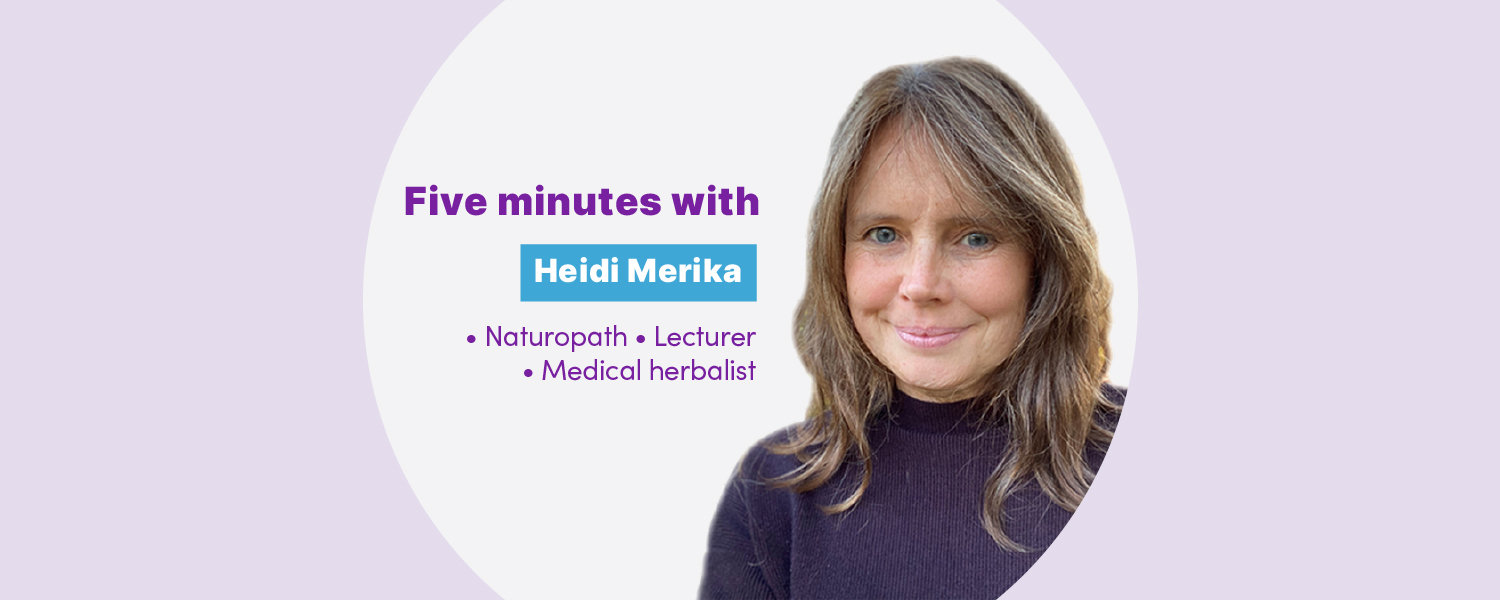
In 5 minutes with ...
Heidi discusses tips for safe and sustainable wildcrafting, and ways to use wildcrafted herbs in the home and the clinic.
Wildcrafting is the practice of foraging for useful plants from their natural, wild habitat for edible or medicinal purposes. The essence of wildcrafting is to harvest wild plants from unpolluted areas in a manner that increases their number and health. Australia has an abundance of native and exotic plants with medicinal properties.
Heidi’s details ...
Naturopath, medical herbalist, lecturer, and author
Founder of the Community Herb School
What environmental factors need to be considered for undertaking and practicing safe wildcrafting? It is important to be mindful of pesticides, herbicides, and other pollutants. An indication that people have been spraying in an area with chemical herbicides or pesticides is what I call ‘the line of death’- where a strip of dead vegetation is surrounded with green vegetation either side. Avoid collecting plants that are dying, discoloured or weird looking. The place where you wildcraft should look vibrant. The foliage should be vibrantly healthy, and if not, avoid wildcrafting in that area because there is a high likelihood of pollution or poor-quality soils.
What are some tips for sustainable wildcrafting? You want to look for places where the plants are really healthy, and also really abundant. Only wildcraft where you can leave a really thriving population, and only take as much as you can realistically use. You would never take everything from an area. You always want to make sure that a plant community can sustain itself and regrow.
How important is plant identification? The biggest factor to keep in mind when wildcrafting is plant identification. In order to wildcraft safely, you need to be really confident in your plant identification. The best way to do that is to have an experienced guide go out with you in the field or in the backyard and show you the plants.
The second- best way is to look in plant ID books or online and identify the plants through those images. Always start small! Start with just three to five plants and get really familiar with them. Get to the point where you can identify a plant, even at its seedling stage, and in any sort of shape and size. It takes years to develop this level of familiarity, where you are one hundred percent certain of your plant identification, so it really is important to start small. Start with what is immediately in your environment, for example, the plants growing beside your backdoor step, or growing in your yard. Or if you live in the city, look at what is growing in the parks or vacant lots around where you live, and in the community gardens. Those are the plants that will be in your life day in, day out. So they are the ones that are worth getting to know.
For many of the plants included in my wildcrafting book, there was little or no information. It was literally just me walking down the street or walking around my block or going in my backyard and going, what is this? And trying to find out what it was and what I could do with it. I would search PubMed for any information. Most of the plants were actually from Asia and Africa, and there was a lot of information in PubMed from Asian and African universities. For example, there is an amazing article out of the Philippines on the sow thistle weed, which you will often see in carparks and roundabouts, talking about its use for anxiety, depression, pain management and HIV infection.
How can wildcrafted herbs and plants be prepared and used back in the home or clinic? There are a few ways to use herbs, such as making tinctures and glycetracts, with either fresh plant or dried plant. I make a lot of fresh tinctures, although I am going through a bit of a transition where I am moving away from tinctures and using more herbal teas, glycetracts and alcohol-free preparations. I have been looking more at the energetics of alcohol, particularly from a TCM or an Ayurvedic perspective. Alcohol is a strong medication in and of itself, and it is not always the ideal menstruum.
I encourage people to use herbs as a fresh tea. My clinic is at my home, so I will take people into the garden, and show them herbs, to make as a fresh tea or juice. For example, I might pull out some cobblers pegs for a tea, or pick some Lemon Myrtle leaves off the tree, and tell people to boil them up three times a day for a cold. Fresh teas and juices are really easy. Even herbs which are only available for a few months of the year, for example the common chickweed, can be juiced and put into ice cubes for later use. Storing these herbs in ice cubes is particularly good if you want to use them later as a poultice. I also use them to make an anti-inflammatory gel by mixing them with a laponite gel base.
Thank you for your time Heidi.






